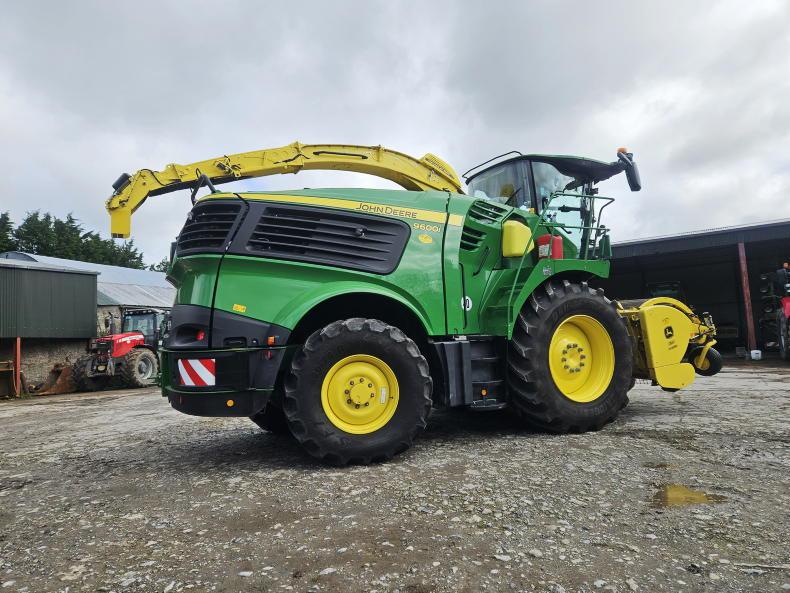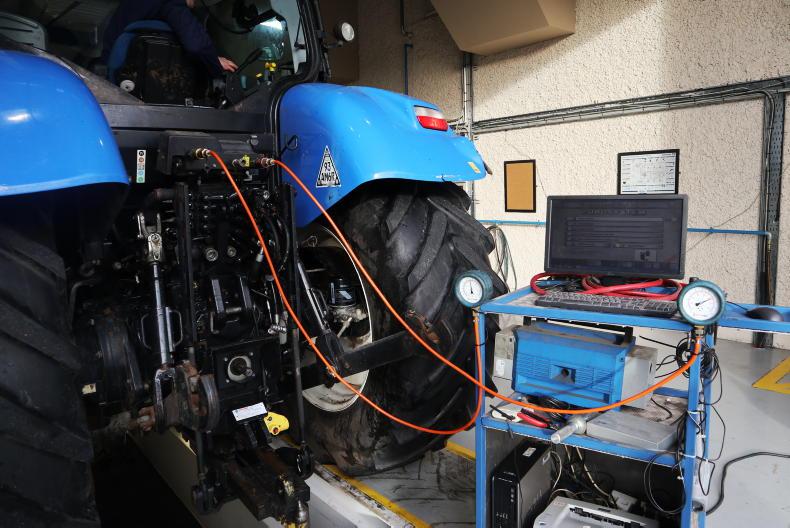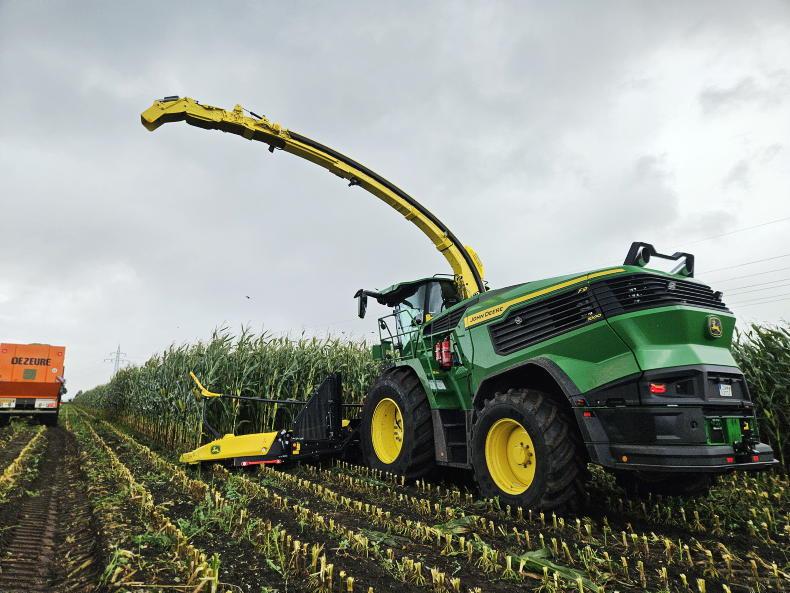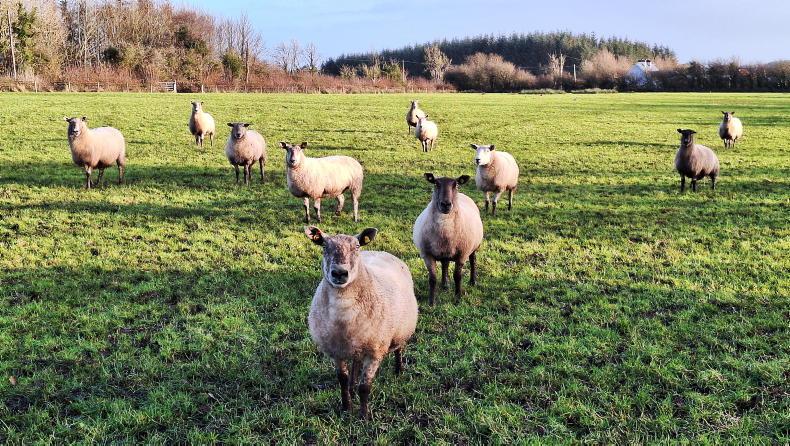Bertie Cahill has been contracting all his life, and judging by his love of machinery and impressive yard of kit, he has no plans to hang up the keys just yet.
Based just outside the town of Ballingarry, Co Limerick, Bertie has seen huge changes in mechanisation as a contractor since he started his own contracting business 43 years ago. Silage was always, and continues to be, his main contracting enterprise.
“I started off with a JF FC80 precision chop side-mounted harvester in 1980. I pulled it with a new 130hp, four-wheel drive John Deere 4240 off Geary’s Garage in Kilmeedy. This sparked a lifelong partnership with the John Deere dealer. I remember John Geary senior asking me could he bring this particular tractor to the machinery show, which was taking place at the RDS in Dublin at the time. That same year saw a lot of bad hay made. I remember most farmers mowed their own silage that year, and I picked it up with the JF. I probably picked up 300-400 acres that year”.
In May 1982, Bertie made the move to a new John Deere 3760, which was a trailed precision-chop harvester. Not one to rest on his laurels, he replaced it with a new 3760 in May 1984.
It was on 30 May 1986 that Bertie bought his very first self-propelled John Deere harvester, which was a new 5830. Although New Holland was the market leader at the time, this didn’t faze Bertie who went on to buy two more new 5830s over the course of the following six years.
“We used to call the 5830 the coffin box. The transfer from the drum to the blower was a disaster on them. It would often block and it was a nightmare to clear it. But it was as good as what was on the market at the time,” he explained.
On 7 May 1992, he bought a new 6810, followed by another one in 1993 and another in 1996. Bertie remarked that the first 6000 series machine he bought broke his heart, and that it nearly broke him. He noted that he once nearly bought a Claas. However, he stuck with the dealer and the brand and is content that he has reaped the rewards in the years that followed.

"The harvester has a very impressive and comfortable cab, which is well laid out".
On 31 May 1999, Bertie bought his ninth new John Deere forager, which was a 6850. Six years later, a new 7400 arrived, followed by a new 7450 in 2010 and a new 7480 in 2014. In 2019, Bertie made the leap to a new 8600i. His current and last new chopper came in May 2021, which was a 9600i wide-body machine.
Wide body
Asked why has he gone down the route of a 787hp self-propelled harvester for grass work, Bertie explained: “It was a gradual systems change over the years. I bought a four-rotor Krone rake in 2020. My last machine (8600i) was a narrow-body machine, and it wasn’t fit to handle four and five heavy swaths raked into one large swath day in day out.
“This meant we had to pick our jobs to suit the big rake. With the wide-body machine, we raked every job with the four-rotor rake this year. I can increase my output by 15% each day. Once you have the capacity to handle it, the big swaths are a great job. Your forward speed is greatly reduced, probably down to 7km/h in first cut. However, you’re getting through ground much faster.
“The big thing I will say with a four-rotor rake is that you need an operator, not a driver. Otherwise, you’re as well to leave the big rake at home. Despite all, we still have the two-rotor rake, and I’d be sceptical about selling it just yet.

The forager is fitted with the 639 pick-up, which is developed by Kemper for John Deere.
“I’m also very lucky to have a good harvester driver who understands the machine, and knows its limits and how to get the very most from the machine.”
Engine and transmission
Bertie’s 9600i has a rated power of 740hp and a maximum power of 776hp. Power in the 9500, 9600 and 9700 models is sourced from an 18l John Deere engine. Meanwhile, the two flagship 9800 and 9900 machines source power from a 24.2l Liebherr V12 engine.
The forager is equipped with John Deere’s ProDrive hydrostatic transmission. This allows for automatic shifting across two preset speed ranges in which the operator selects a speed that will be maintained continuously in the field. By pulling back the lever, two brake units, and the parking brake engage automatically.

Harvest Lab is essentially a sensor that uses near-infrared (NIR) spectroscopy to analyse the various constituents within harvested crops.
If the wheels lose traction on a 4WD harvester, the hydraulic flow is automatically directed to the wheels that still have grip to help keep the machine moving. Travelling at a speed of 40km/h while maintaining an engine speed of 1,200rpm means the machine is efficient on the road.
Pickup
The forager is fitted with the 639 pickup, which is a 3m wide unit with a 2.56m working width. Kemper developed this pickup for John Deere. All wearing parts across the machine are specified with the Dura Line parts package, which are heavy duty wear parts that John Deere say will last four times longer.

The forager is equipped with John Deere’s ProDrive hydrostatic transmission.
Unlike some other manufacturers, John Deere has continued to use a four-tine bar pickup reel with a cam track. The header comes with a variable header drive. This feature automatically synchronises the speed of the pickup reel and the auger with the feeding speed and length of chop through a hydrostatic IVT drive system, for a consistent crop flow through the machine. The pickup also has a dual header drive.

Bertie Cahill.
This system features individual hydraulic drive of the pickup tines, matching their speed with the machine’s ground speed.
“The pickup offers great lateral flotation. In fairness, it follows the ground very well, but at times I feel this could be a little better. But John Deere have made big improvements to the pickup throughout the years,” explained Bertie.
Feed rollers
Although some manufacturers have gone for six-feed rollers, John Deere is continuing to stick with the four-spring loaded rollers. The 9000 series also have a hydraulic feed roll dampener beside the four rollers. This helps to keep a constant pressure on the flow of forage through the machine, for a smooth feed of material to the drum.

The pickup features individual hydraulic drive of the pick-up tines, matching their speed with the machines ground speed.
The 9000 series machines have an 850mm crop channel as opposed to the 660mm crop channel in the 8000 series, thus allowing increased throughput. Bertie’s 9600i is fitted with a 40-knife drum, the smallest offered in the 9000 series. With the full set in, chop length can be varied from 7-25mm, while with half a set this increases from 14-50mm. Bertie runs 32 knives in his machine.
Harvest Lab NIR sensor
Bertie opted for Harvest Lab with his previous 8600i. This is essentially a sensor that uses near-infrared (NIR) spectroscopy to analyse the various constituents within harvested crops. This same unit can be used in a forager, on a slurry tanker or it can be used as a mobile forage testing unit.
The unit is positioned in the chute of the forage harvester and takes real-time forage information as the harvested grass passes through. The unit takes over 4,000 measurements per second. This information is then compared with algorithms that are based on millions of hours of in-field experience. The unit provides the contractor or farmer with real-time readings on dry matter content, crude protein, starch, crude fibre, NDF, ADF, sugar and crude ash.

Bertie’s 9600i has a rated power of 740hp and a maximum power of 776hp. Power in the 9500, 9600 and 9700 models is sourced from an 18l John Deere engine.
This information can be taken one step further through the John Deere Operations Centre, where yield mapping and an analysis of what areas of the field produced varying levels of crop constituents can be assessed. Variable-rate fertiliser spreading can be used based on the yield maps. When using the unit on a slurry tanker, it has the capability of measuring N, P, K and dry matter. Before application, you can set a target rate for any one nutrient in kg/ha, a limit rate for a second nutrient and even a site-specific prescription map for any field. While spreading, the unit is constantly analysing nutrient levels and will automatically adjust the machine’s speed and/or flow rate to meet the desired target.

“The NIR technology is hugely impressive. It’s very accurate once calibrated several times each season".
“The NIR technology is hugely impressive. It’s very accurate once calibrated several times each season. I’d estimate 90% of our customers are dairy farmers. To be honest I was disappointed with the lack of take up. There is interest, but it hasn’t taken off like I thought it might have, but I can see it growing in popularity going forward. It’s a great asset to have,” added Bertie.
“When we made the investment in the four-rotor rake, we had to upgrade the harvester to match it. It has been a good move for the business, output has increased by 15% and forward speed has decreased.
“Although the harvester has 151hp more, it was the wider feed channel we were after. The harvester has a very impressive and comfortable cab, which is well laid out.

John Deere is continuing to stick with the four-spring loaded rollers.
“The harvester is never lacking in terms of performance, and if you were to choke it, it would solely be down to operator error.
“Overall, I’m very pleased with it. I’ve been running John Deere harvesters all my life, and I’ve no plans to jump brands going forward,” concluded Bertie.
The spec
Engine: 18l John Deere engine.
Max horsepower:
776hp.
Transmission: Pro-drive, autoshift.
Max road speed: 40km/h..
Chopping cylinder: 40-knife.
Feed rollers: four.
Pickup: four tine bars with cam track.
List price: €450,000 plus VAT.
Bertie Cahill has been contracting all his life, and judging by his love of machinery and impressive yard of kit, he has no plans to hang up the keys just yet.
Based just outside the town of Ballingarry, Co Limerick, Bertie has seen huge changes in mechanisation as a contractor since he started his own contracting business 43 years ago. Silage was always, and continues to be, his main contracting enterprise.
“I started off with a JF FC80 precision chop side-mounted harvester in 1980. I pulled it with a new 130hp, four-wheel drive John Deere 4240 off Geary’s Garage in Kilmeedy. This sparked a lifelong partnership with the John Deere dealer. I remember John Geary senior asking me could he bring this particular tractor to the machinery show, which was taking place at the RDS in Dublin at the time. That same year saw a lot of bad hay made. I remember most farmers mowed their own silage that year, and I picked it up with the JF. I probably picked up 300-400 acres that year”.
In May 1982, Bertie made the move to a new John Deere 3760, which was a trailed precision-chop harvester. Not one to rest on his laurels, he replaced it with a new 3760 in May 1984.
It was on 30 May 1986 that Bertie bought his very first self-propelled John Deere harvester, which was a new 5830. Although New Holland was the market leader at the time, this didn’t faze Bertie who went on to buy two more new 5830s over the course of the following six years.
“We used to call the 5830 the coffin box. The transfer from the drum to the blower was a disaster on them. It would often block and it was a nightmare to clear it. But it was as good as what was on the market at the time,” he explained.
On 7 May 1992, he bought a new 6810, followed by another one in 1993 and another in 1996. Bertie remarked that the first 6000 series machine he bought broke his heart, and that it nearly broke him. He noted that he once nearly bought a Claas. However, he stuck with the dealer and the brand and is content that he has reaped the rewards in the years that followed.

"The harvester has a very impressive and comfortable cab, which is well laid out".
On 31 May 1999, Bertie bought his ninth new John Deere forager, which was a 6850. Six years later, a new 7400 arrived, followed by a new 7450 in 2010 and a new 7480 in 2014. In 2019, Bertie made the leap to a new 8600i. His current and last new chopper came in May 2021, which was a 9600i wide-body machine.
Wide body
Asked why has he gone down the route of a 787hp self-propelled harvester for grass work, Bertie explained: “It was a gradual systems change over the years. I bought a four-rotor Krone rake in 2020. My last machine (8600i) was a narrow-body machine, and it wasn’t fit to handle four and five heavy swaths raked into one large swath day in day out.
“This meant we had to pick our jobs to suit the big rake. With the wide-body machine, we raked every job with the four-rotor rake this year. I can increase my output by 15% each day. Once you have the capacity to handle it, the big swaths are a great job. Your forward speed is greatly reduced, probably down to 7km/h in first cut. However, you’re getting through ground much faster.
“The big thing I will say with a four-rotor rake is that you need an operator, not a driver. Otherwise, you’re as well to leave the big rake at home. Despite all, we still have the two-rotor rake, and I’d be sceptical about selling it just yet.

The forager is fitted with the 639 pick-up, which is developed by Kemper for John Deere.
“I’m also very lucky to have a good harvester driver who understands the machine, and knows its limits and how to get the very most from the machine.”
Engine and transmission
Bertie’s 9600i has a rated power of 740hp and a maximum power of 776hp. Power in the 9500, 9600 and 9700 models is sourced from an 18l John Deere engine. Meanwhile, the two flagship 9800 and 9900 machines source power from a 24.2l Liebherr V12 engine.
The forager is equipped with John Deere’s ProDrive hydrostatic transmission. This allows for automatic shifting across two preset speed ranges in which the operator selects a speed that will be maintained continuously in the field. By pulling back the lever, two brake units, and the parking brake engage automatically.

Harvest Lab is essentially a sensor that uses near-infrared (NIR) spectroscopy to analyse the various constituents within harvested crops.
If the wheels lose traction on a 4WD harvester, the hydraulic flow is automatically directed to the wheels that still have grip to help keep the machine moving. Travelling at a speed of 40km/h while maintaining an engine speed of 1,200rpm means the machine is efficient on the road.
Pickup
The forager is fitted with the 639 pickup, which is a 3m wide unit with a 2.56m working width. Kemper developed this pickup for John Deere. All wearing parts across the machine are specified with the Dura Line parts package, which are heavy duty wear parts that John Deere say will last four times longer.

The forager is equipped with John Deere’s ProDrive hydrostatic transmission.
Unlike some other manufacturers, John Deere has continued to use a four-tine bar pickup reel with a cam track. The header comes with a variable header drive. This feature automatically synchronises the speed of the pickup reel and the auger with the feeding speed and length of chop through a hydrostatic IVT drive system, for a consistent crop flow through the machine. The pickup also has a dual header drive.

Bertie Cahill.
This system features individual hydraulic drive of the pickup tines, matching their speed with the machine’s ground speed.
“The pickup offers great lateral flotation. In fairness, it follows the ground very well, but at times I feel this could be a little better. But John Deere have made big improvements to the pickup throughout the years,” explained Bertie.
Feed rollers
Although some manufacturers have gone for six-feed rollers, John Deere is continuing to stick with the four-spring loaded rollers. The 9000 series also have a hydraulic feed roll dampener beside the four rollers. This helps to keep a constant pressure on the flow of forage through the machine, for a smooth feed of material to the drum.

The pickup features individual hydraulic drive of the pick-up tines, matching their speed with the machines ground speed.
The 9000 series machines have an 850mm crop channel as opposed to the 660mm crop channel in the 8000 series, thus allowing increased throughput. Bertie’s 9600i is fitted with a 40-knife drum, the smallest offered in the 9000 series. With the full set in, chop length can be varied from 7-25mm, while with half a set this increases from 14-50mm. Bertie runs 32 knives in his machine.
Harvest Lab NIR sensor
Bertie opted for Harvest Lab with his previous 8600i. This is essentially a sensor that uses near-infrared (NIR) spectroscopy to analyse the various constituents within harvested crops. This same unit can be used in a forager, on a slurry tanker or it can be used as a mobile forage testing unit.
The unit is positioned in the chute of the forage harvester and takes real-time forage information as the harvested grass passes through. The unit takes over 4,000 measurements per second. This information is then compared with algorithms that are based on millions of hours of in-field experience. The unit provides the contractor or farmer with real-time readings on dry matter content, crude protein, starch, crude fibre, NDF, ADF, sugar and crude ash.

Bertie’s 9600i has a rated power of 740hp and a maximum power of 776hp. Power in the 9500, 9600 and 9700 models is sourced from an 18l John Deere engine.
This information can be taken one step further through the John Deere Operations Centre, where yield mapping and an analysis of what areas of the field produced varying levels of crop constituents can be assessed. Variable-rate fertiliser spreading can be used based on the yield maps. When using the unit on a slurry tanker, it has the capability of measuring N, P, K and dry matter. Before application, you can set a target rate for any one nutrient in kg/ha, a limit rate for a second nutrient and even a site-specific prescription map for any field. While spreading, the unit is constantly analysing nutrient levels and will automatically adjust the machine’s speed and/or flow rate to meet the desired target.

“The NIR technology is hugely impressive. It’s very accurate once calibrated several times each season".
“The NIR technology is hugely impressive. It’s very accurate once calibrated several times each season. I’d estimate 90% of our customers are dairy farmers. To be honest I was disappointed with the lack of take up. There is interest, but it hasn’t taken off like I thought it might have, but I can see it growing in popularity going forward. It’s a great asset to have,” added Bertie.
“When we made the investment in the four-rotor rake, we had to upgrade the harvester to match it. It has been a good move for the business, output has increased by 15% and forward speed has decreased.
“Although the harvester has 151hp more, it was the wider feed channel we were after. The harvester has a very impressive and comfortable cab, which is well laid out.

John Deere is continuing to stick with the four-spring loaded rollers.
“The harvester is never lacking in terms of performance, and if you were to choke it, it would solely be down to operator error.
“Overall, I’m very pleased with it. I’ve been running John Deere harvesters all my life, and I’ve no plans to jump brands going forward,” concluded Bertie.
The spec
Engine: 18l John Deere engine.
Max horsepower:
776hp.
Transmission: Pro-drive, autoshift.
Max road speed: 40km/h..
Chopping cylinder: 40-knife.
Feed rollers: four.
Pickup: four tine bars with cam track.
List price: €450,000 plus VAT.



















SHARING OPTIONS